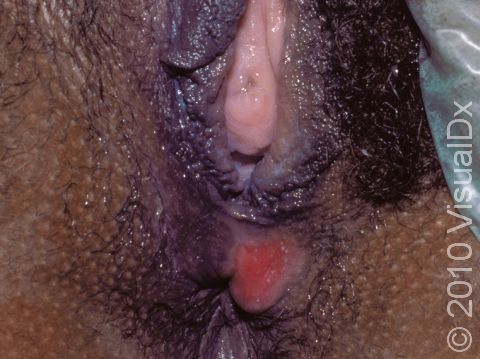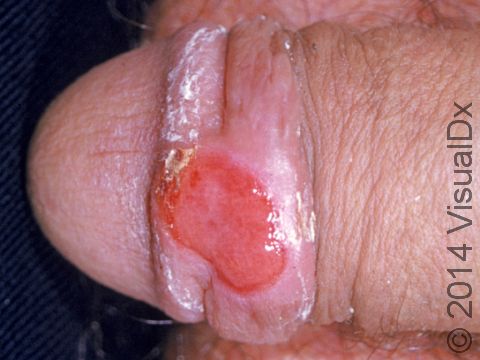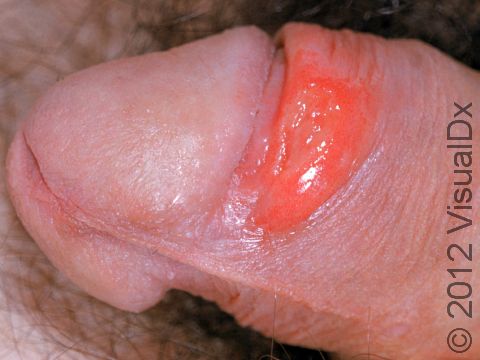Primary Syphilis
Primary syphilis is a sexually transmitted infection (STI) caused when a bacterium called Treponema pallidum penetrates broken skin, such as on the genitals or the mucous membranes of the mouth or anus. Primary syphilis is usually passed on to others through sexual contact, but it can also be passed from an infected pregnant person to their unborn baby. There are 3 stages of infection: primary syphilis, secondary syphilis, and tertiary syphilis. It is important to treat the infection in the primary stage or the infection will progress and may cause damage to the nervous system and the heart, leading to early death.
Syphilis can be completely cured if treated early. Healed infection leaves no immunity, meaning you can get infected again.
Who's At Risk?
Syphilis occurs worldwide. In the United States, the rates of disease are higher in urban areas and the Southern states.
Syphilis is most common in men who have sex with men, but anyone who is sexually active can get syphilis from an infected partner through vaginal, anal, or oral sex without a condom. Syphilis is more common in people who have HIV. Because syphilis can be passed along during pregnancy, pregnant individuals should receive testing for syphilis at the beginning and end of their pregnancy.
Signs & Symptoms
A painless ulcer (a sore that is missing the top layer of the skin or mucous membrane) called a chancre appears 18-21 days after the initial infection. In women, genital sites commonly affected include the cervix, vagina, vulva, and clitoris. Cervical and vaginal syphilis infections may not be visible. In men, the chancre is easily seen on the penis or other locations of infection. Common sites are around the mouth and between the buttocks.
Chancres vary in size from a few millimeters to several centimeters. A chancre is usually pink, painless, solitary, and shallow, with a sharp border and a raised, firm edge. It is common for individuals with syphilis to have rubbery, nontender, swollen lymph nodes during the first week of infection.
The chancre typically lasts for 10-14 days and then heals.
Self-Care Guidelines
Syphilis in the primary stage can heal without treatment, making it easy to mistake it for something less serious. However, if you are sexually active and suspect you have been exposed to syphilis or have an ulcer in the mouth, genital area, or anal area, you should seek medical care urgently. Syphilis is highly contagious, and you should avoid any further sexual activity and notify any previous sexual partners while awaiting medical care.
Syphilis can be prevented by abstaining from casual sexual activity and by using condoms correctly during any sexual contact. If you are in a long-term relationship, make sure you know your partner’s sexual history or ask your partner to be tested prior to engaging in sexual activity.
Treatments
The medical professional may do blood and fluid tests to confirm the diagnosis.
The medical professional will prescribe penicillin (or potentially another antibiotic if you are allergic to penicillin) to treat the infection. The medical professional may also want to test for other STIs that are often present along with syphilis.
If you are diagnosed with syphilis, any sexual partners within the last 90 days may also be infected and should be treated for syphilis as well.
Do not engage in sexual activity until the chancre is healed and follow-up blood tests have shown that the infection has been cured.
Visit Urgency
See your medical professional immediately:
- If you are sexually active and have any ulcer in the genital, mouth, or anal area or suspect you have been exposed to someone with syphilis. While awaiting medical care, avoid sexual activity and notify any sexual partners of your illness.
- If you have had intimate contact with someone with syphilis, have been using intravenous drugs, or if you have engaged in sex with multiple or unknown partners.
Trusted Links
References
Bolognia J, Schaffer JV, Cerroni L. Dermatology. 4th ed. Philadelphia, PA: Elsevier; 2018.
Centers for Disease Control and Prevention. Syphilis – CDC Basic Fact Sheet. CDC. https://www.cdc.gov/std/syphilis/stdfact-syphilis.htm. Updated 2022 Feb 10.
James WD, Elston D, Treat JR, Rosenbach MA. Andrew’s Diseases of the Skin. 13th ed. Philadelphia, PA: Elsevier; 2019.
Kang S, Amagai M, Bruckner AL, et al. Fitzpatrick’s Dermatology. 9th ed. New York, NY: McGraw-Hill Education; 2019.
Last modified on June 18th, 2024 at 2:31 pm

Not sure what to look for?
Try our new Rash and Skin Condition Finder


